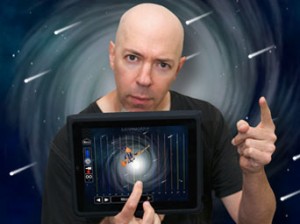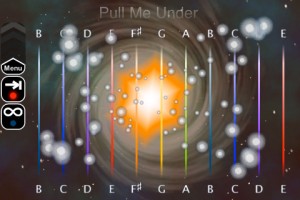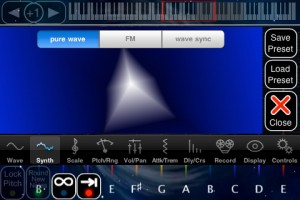How to Make a Best-Selling iPhone and iPad App: Jordan Rudess & the Creation of MorphWiz
MIDTOWN, MANHATTAN: As if becoming a master of your craft weren’t challenging enough, now in the world of apps we must invent entirely new crafts to master.
Not surprisingly, Jordan Rudess, virtuoso mad-science keyboardist of cornerstone NY prog-rockers Dream Theater, is always up for just such a task. To that end, he’s created an ongoing series of music/media apps for the iPhone and iPad, each one more successful than the last.
With his latest effort, the mind-bending MorphWiz, he’s set a standard he may meet but never beat – it was a #1 seller on iTunes and has taken in a load of awards since then, including Billboard’s “Best Music Creation App”. Inspired by Rudess’ experience with helping to design the Haken Continuum Fingerboard MIDI instrument, MorphWiz ($9.99) is a vertical-grid-based musical instrument that allows a great deal of expressive control with real-time, highly organic, animated visual feedback.
As creative and intuitive as it is to use, however, pulling MorphWiz together was an arduous task – as the construction of most quality apps are. In this interview, Rudess took the time to break down the A-Z of how an app is born, from inspiration to conception, partnership to programming, marketing plan to a place on the iTunes store. To learn how to get your own iPhone/iPad app together, just read on.
What first got you thinking about creating iPhone apps?
Well, the light really came on as soon I realized that music was possible on the iPhone. It was one of the original piano apps I saw a couple of years ago that sparked my imagination – I just touched a key on the iPhone, it made a sound and I thought, “This is cool.”
From there, what made you go from enjoying other people’s iPhone apps to thinking you needed to create one of your own?
The iPhone world is something that exploded rather quickly, and when it became clear that you could do creative things with it, a lot started happening. I was very much on top of all the developments, I started to realize the full potential of the device and it got my mind somewhat soaring.
I started to think of a lot of creative ideas, and I reached out to some of the people doing the coolest things in the iPhone world. One company was Amidio, based in Moscow, so I reached out to them and they were interested in working with me. Funny enough, I had a trip to Russia planned with Dream Theater, so I met with their programmer Toyo Bunko, and he and I made plans to release an app which ended up being called JR Hexatone.
JR Hexatone is an app that was really a sound-sequencing app, which lent itself very much towards the whole electronica/glitchy type of movement. That came out in 2009, and was really the beginning of apps that had my name associated with it.
From there, one of the popular apps that I worked on is Bebot, which is a vertical controller in some ways similar to MorphWiz where the note is spread across the screen in vertical lines. That kind of control is something I’ve been interested in for quite a long time, and also because of my Continuum designed by Lippold Haken.
Somewhere along the line I discovered an app that was called 4D Synth, and that inspired me too. I wrote a letter to the guy who programmed it, Kevin Chartier, that started a conversation, and we decided we wanted to work together to write a brand new app that really demonstrated my vision.
Sounds like it pays to keep your eyes open, and find people who have a track record. After you connected with Kevin, what guided you to the exact type of app you would produce first?
A primary thing about MorphWiz was that it would have this kind of Bebot/Continuum note grid and vertical line control design, where each line had the ability to have some expression on them. But beyond that I wanted to have an instrument that was a combination of visual and audio. It’s been my desire to bring together the world of audio and video as one. I think they are one, and this app technology allows us to have as little separation as possible.
Kevin and I worked very hard on merging these two worlds, and we came up with MorphWiz. The idea was, “How could we morph from one sound to another, and also morph from one image to another, and have them really correspond?” The basic waveforms of MorphWiz are sine, triangle, sawtooth and square, so we gave each waveform a visual image, then experimented with how we would not only morph audio but the visuals. So when you put your hand on the playing surface of MorphWiz, you can have the waveforms morph from one to another and at the same time get a visual representation of what they’re doing.
Although MorphWiz only shows you a visual representation of the last note you hit, sonically it’s morphing every note you play independently. That’s the very deep foundation of the program – too deep for most people to even realize what’s happening. On a traditional synth, for example, if you’re bending one note, you’re going to bend them all. But with MorphWiz the idea is that every note is an independent voice and each note can be expressed on its own, in that you could play three notes, bend one and not the other, bend one up and the other down…things like that in real time.
Sounds like it helps to be ambidextrous!
Sure. You can play two notes at the same time, bending one in with one finger, and bending the other while the first is fading out.
So once you have an app concept, what kind of team and resources are actually needed to design it and test it?
That’s a good question. My company is very, very small – it basically stared out as two people. One of us is a professional programmer/musician/music lover, and the other is a professional musician — that’s me – who’s very interested in technology, controllers, and different ways to make sound and visuals. We’ve found ours is a great combination to bring apps to the world because we can successfully conceive of them, make them and then market them.
In MorphWiz’s case, I have a musical career and people know me as someone who plays a lot of interesting sound-controlling devices. That along with my other complementary careers presenting technology, educating – all of that combined with Kevin’s immense programming skills make this work.
But there’s a lot of ways people can make this work. A lot of companies have people that they can assign the tasks more easily among them so that one person does coding, the other does marketing, and the does the demo, etc… Our organization is very small, but between us we have the parameters that we need.
As far as funding is concerned, in a lot of companies someone will come up with an app, and then need money to hire a programmer from the outside to make it happen. In our case, it was a work of passion: This was something we wanted to do, and make this vision happen. Kevin has a full-time job working for the government, and every spare minute he’d program. I have my full time job working with Dream Theater as a musician, and in my spare time I’d be talking with Kevin, conceptualizing, testing, playing it, and after it’s out calling the media for interviews and going to conventions.
The reason we didn’t need any funding in the beginning was that we were almost possessed with the joy of what we were creating. So either this thing will proceed to the next level and we’ll keep having fun with it, or we’ll get funding and it will expand that way.
Can you give us a deeper look at the workflow between creative and programming – or you and Kevin, in this case?
I generally have a fairly strong vision of what I want, and as soon as I present something to Kevin, he’s generally right there with me. Kevin is not just a programmer – he loves music and graphics, and we’d have a great time online when we’d pick the visuals to represent the waveforms. We’d look at something and say, “Maybe those colors aren’t rich enough. Can you make it a little more angular? A little more opaque?” Once there’s something on the screen to look at, then we can make changes from there.
After that, how is an app actually brought to market/onto the iTunes store?
From my experience, it seemed very complicated putting things into the store. We had to make these special builds, type in a lot of information, get very accurate descriptions together, put up special graphics, make a Website, put it up on Facebook, and make sure all the bases are covered.
It’s not that easy. Apple requires you to have a full support system in place – you even need to make a video. There’s a lot of required elements that go into making the app. It takes a lot of patience. MorphWiz from start to finish was about a nine-month ordeal.
Don’t try to market your app without the assistance of YouTube!
Apparently it was worth it: Morphwhiz went to #1 on the iTunes store within a few days of its release. What do you think allowed you to attain such quick success?
Well, two things, one of which is that I think it’s a really together app. It’s an app that’s very fun for young people to play because it looks really colorful and it’s playful. There’s a lot of different patches, they all look different, and it’s a really good time. But even for a pro musician, it offers some very unique features that you just don’t find on any other instrument. So we had an app that captured all ages, all different levels, and different interests in music.
Of course, it can happen that the product is amazing and no one even knows about it. But we were very aggressive about making sure the world knew about it, contacting all the music press, putting it up onstage with Dream Theater, talking about it in every interview. It all keeps things in motion.
Six months later after MorphWiz came out, what would you identify as the challenges and rewards of creating an app? What’s easy about it, and what’s proven tougher than you expected?
There’s a lot of upkeep. If you want your app to continue to be successful, then you have to work it. I go to shows like the San Francisco MusicTech Summit, before that I was at the San Francisco App Show, and prior to that I was at the Billboard Awards where it was voted the #1 Music Creation App. I play it whenever I can in public, and I just think it’s the kind of app that can be around for a long time.
We get to upgrade it as well, and we have some cool upgrade paths for MorphWiz to go down. Just to make sure it remains vital is a big job. That’s maybe the tough part – to keep the business running and not lose the momentum.
The rewarding part is that once you do all the work, get it submitted, it’s good, and people know about it, then people buy it and enjoy it. That part’s cool.
That sounds very cool! So in short, what advice would you give to people reading this who may be thinking about their first app?
Good luck! (laughs) If it’s a music app then you have to make sure that it’s going to really sound good. I tell people, “Make sure it sounds good and looks good, even if it’s really simple.” It’s fine if it can only do one thing, but it has to be quality. If its buggy that would be a problem, but if it does what it says it does, and is entertaining/fun/useful, that’s all you need.
I would also say that there’s two level of apps, in the sense you can make something very deep, complex and powerful, or you can make something that’s very straight-ahead, and that’s OK as well. A good example of how one thing can lead to another is my newest app, SketchWiz. It’s not a music app, but it’s something that stemmed out of developing MorphWiz – it’s caught on and become a big thing in the photography area.
Ready for a Scoop? We have an app that we’re releasing at NAMM called MorphWiz MIDI. It’s a MorphWiz engine that can run any MIDI synth.
That’s juicy! Listening, everybody? Shifting gears, do you think NYC is a particularly good breeding ground for app developers, in your opinion?
Well, I don’t know. I’m from NYC, but my partner’s from Florida. I know that there’s a lot of very creative people in NYC, and programmers from NYU with a great technology education. NYC has always been a hub of creativity and technology, as well, just like San Francisco or L.A.
I’m watching the world come into the whole app thing, like Korg, which is doing some stuff now that’s kind of cool. I’m just very aware of these bigger organizations that are trying to play this game, like ReBirth coming out for the iPhone and iPad. It’s about to become a whole different animal where big companies take over. But at the same time, you have a lot of seeds coming out of New York.
On the other hand, you’ve teamed up with programmers from Moscow to Florida. When it comes to the app world, it seems like it doesn’t matter where anybody is located, as long everyone’s on the same page.
Absolutely, I didn’t even meet Kevin in person until we were six months into the project. We did everything over Skype, phone, and email. It all worked out, and we met after we submitted the app — it’s a new world out there.
— David Weiss
Please note: When you buy products through links on this page, we may earn an affiliate commission.










DJG
December 21, 2010 at 11:46 pm (13 years ago)I may not like Rudess’ nerdy music, but the apps he’s hired others to create are pretty cool. He’s done a great job of marketing them and promoting the iPhone as a platform for music lovers, nerdy and otherwise.
It should be noted that the iPad app market is significantly smaller than the iPhone app market, so any app that comes out for iPad will have a better chance of visibility.
On top of that, the overall app success rate is different depending on where you look.
According to top app charts though, Morphwiz only went #2 in music and only #40 over all. And they get their data directly from Apple.
KC
December 22, 2010 at 8:46 pm (13 years ago)I’m not sure why Top App Charts says differently, but MorphWiz did reach #1 in the music section of the United States iPad app store (on June 23, 2010). AppAnnie confirms this:
http://www.appannie.com/morphwiz/ranking/#view=best-ranks&device=ipad
DJG
December 22, 2010 at 11:55 pm (13 years ago)Yeah, me neither. App Annie looks like a great site though. Thanks!